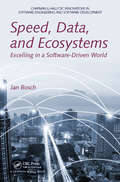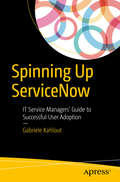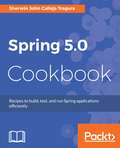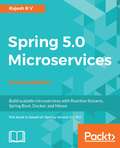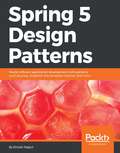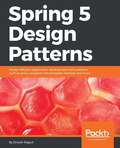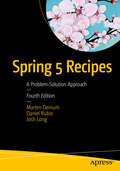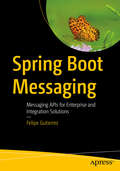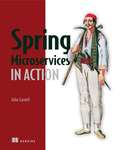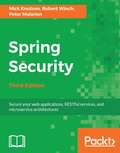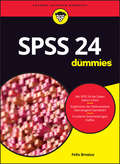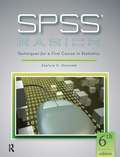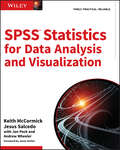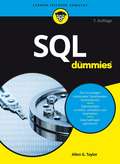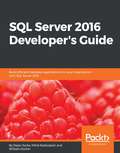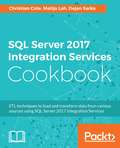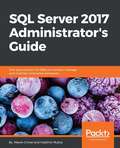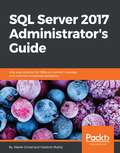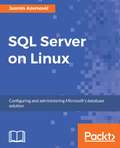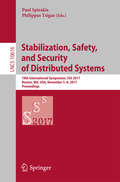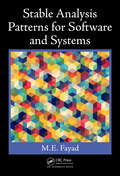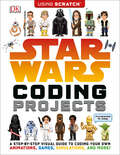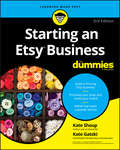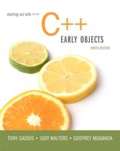- Table View
- List View
Speed, Data, and Ecosystems: Excelling in a Software-Driven World (Chapman & Hall/CRC Innovations in Software Engineering and Software Development Series)
by Jan BoschAs software R&D investment increases, the benefits from short feedback cycles using technologies such as continuous deployment, experimentation-based development, and multidisciplinary teams require a fundamentally different strategy and process. This book will cover the three overall challenges that companies are grappling with: speed, data and ecosystems. Speed deals with shortening the cycle time in R&D. Data deals with increasing the use of and benefit from the massive amounts of data that companies collect. Ecosystems address the transition of companies from being internally focused to being ecosystem oriented by analyzing what the company is uniquely good at and where it adds value.
Spinning History: Politics and Propaganda in World War II
by Nathaniel LandeAn “original and insightful” look at World War II through the lens of theater, propaganda, and the most important performances in human history (Richard Cole, PhD). In this fascinating book, more relevant than ever in today’s political climate of “fake news” and “alternative facts,” bestselling author and historian Nathaniel Lande presents WWII as a drama staged and overseen by four contrasting masters: Roosevelt, Churchill, Hitler, and Stalin. Each man had his own script for elaborately produced campaigns of deception, winning hearts and minds on the frontlines and the home front. Each leader used all the tools at his disposal to promote his own narrative of the Second World War. Brilliantly conceived oratory was applied to underscore each vision. Impression management—the art of political spin—was employed to drive the message home. Each side employed uniforms, meticulously staged events, and broadcast their messages via all media available—motion pictures, radio broadcasts, songs, posters, leaflets, and beyond. The result of Lande’s exploration is “an illuminating, readable, and still very relevant account of the ways in which theatrical staging, dramatic storytelling, and message manipulation were key to the efforts of both sides during those turbulent years” (Richard Zoglin, senior editor, Time).
Spinning Up ServiceNow
by Gabriele KahloutLearn how to onboard ServiceNow ITSM tools by evangelizing, educating, and coordinating your organization's service desk, developers, and stakeholders. Drawing on his own story of lessons learned in spinning up the adoption of ServiceNow throughout the Al Jazeera Media Network, application architect Gabriele Kahlout shows IT service managers how to launch automated ServiceNow ticketing tools in seamless integration with their organization's existing email and Active Directory.Spinning Up ServiceNow: IT Service Managers' Guide to Successful User Adoption shows you how to orchestrate your IT service desks and developers to facilitate the adoption and consumption of IT services by all users, supporting their various business needs while optimizing human-computer interaction and minimizing stress and productivity loss arising from poor human-system design.What You'll LearnQuick-start ServiceNow in a matter of days with the minimum configuration required to start processing tickets via emailAvoid the teething problems that can spoil your users’ onboarding experience with ServiceNowAutomate the process of scaling up new teams into ServiceNowShape your users' experiences so that they retain their familiar bearings in email and Active Directory while welcoming the power of ServiceNow enhancementsCreate a strategy to avoid common pitfalls that sabotage ITSM programsWho This Book Is For IT managers charged with implementing ServiceNow ITSM suites in their organizations and business analysts determining the requirements for such implementation. The secondary readership is system administrators and developers involved in ITSM.
Spring 5.0 Cookbook
by Sherwin John TraguraOver 100 hands-on recipes to build web applications easily and efficiently IN Spring 5.0 About This Book • Solve real-world problems using the latest features of the Spring framework like Reactive Streams and the Functional Web Framework. • Learn how to use dependency injection and aspect-oriented programming to write compartmentalized and testable code. • Understand when to choose between Spring MVC and Spring Web Reactive for your projects Who This Book Is For Java developers who would like to gain in-depth knowledge of how to overcome problems that they face while developing great Spring applications. It will also cater to Spring enthusiasts, users and experts who need an arena for comparative analysis, new ideas and inquiries on some details regarding Spring 5.0 and its previous releases. A basic knowledge of Spring development is essential What You Will Learn • Understand how functional programming and concurrency in JDK 1.9 works, and how it will affect Spring 5.0 • Learn the importance and application of reactive programming in creating services, and also the process of creating asynchronous MVC applications • Implement different Spring Data modules • Integrate Spring Security to the container • Create applications and deploy using Spring Boot • Conceptualize the architecture behind Microservices and learn the details of its implementation • Create different test cases for the components of Spring 5.0 components In Detail The Spring framework has been the go-to framework for Java developers for quite some time. It enhances modularity, provides more readable code, and enables the developer to focus on developing the application while the underlying framework takes care of transaction APIs, remote APIs, JMX APIs, and JMS APIs. The upcoming version of the Spring Framework has a lot to offer, above and beyond the platform upgrade to Java 9, and this book will show you all you need to know to overcome common to advanced problems you might face. Each recipe will showcase some old and new issues and solutions, right from configuring Spring 5.0 container to testing its components. Most importantly, the book will highlight concurrent processes, asynchronous MVC and reactive programming using Reactor Core APIs. Aside from the core components, this book will also include integration of third-party technologies that are mostly needed in building enterprise applications. By the end of the book, the reader will not only be well versed with the essential concepts of Spring, but will also have mastered its latest features in a solution-oriented manner. Style and Approach This book follows a cookbook style approach, presenting a problem and showing you how to overcome it with useful recipes. The examples provided will help you code along as you learn.
Spring 5.0 Microservices - Second Edition
by Rajesh R VA practical, comprehensive, and user-friendly approach to building microservices in Spring About This Book • Update existing applications to integrate reactive streams released as a part of Spring 5.0 • Learn how to use Docker and Mesos to push the boundaries and build successful microservices • Upgrade the capability model to implement scalable microservices Who This Book Is For This book is ideal for Spring developers who want to build cloud-ready, Internet-scale applications, and simple RESTful services to meet modern business demands. What You Will Learn • Familiarize yourself with the microservices architecture and its benefits • Find out how to avoid common challenges and pitfalls while developing microservices • Use Spring Boot and Spring Cloud to develop microservices • Handle logging and monitoring microservices • Leverage Reactive Programming in Spring 5.0 to build modern cloud native applications • Manage internet-scale microservices using Docker, Mesos, and Marathon • Gain insights into the latest inclusion of Reactive Streams in Spring and make applications more resilient and scalable In Detail The Spring Framework is an application framework and inversion of the control container for the Java platform. The framework's core features can be used by any Java application, but there are extensions to build web applications on top of the Java EE platform. This book will help you implement the microservice architecture in Spring Framework, Spring Boot, and Spring Cloud. Written to the latest specifications of Spring that focuses on Reactive Programming, you'll be able to build modern, internet-scale Java applications in no time. The book starts off with guidelines to implement responsive microservices at scale. Next, you will understand how Spring Boot is used to deploy serverless autonomous services by removing the need to have a heavyweight application server. Later, you'll learn how to go further by deploying your microservices to Docker and managing them with Mesos. By the end of the book, you will have gained more clarity on the implementation of microservices using Spring Framework and will be able to use them in internet-scale deployments through real-world examples. Style and approach The book takes a step-by-step approach on developing microservices using Spring Framework, Spring Boot, and a set of Spring Cloud components that will help you scale your applications.
Spring 5 Design Patterns
by Dinesh RajputThis book is for developers who would like to use design patterns to address common problems while designing an app using the Spring framework. Basic knowledge of the Spring framework and Java is assumed.
Spring 5 Design Patterns
by Dinesh RajputLearn about design patterns and best practices required with the Spring Framework to solve common problems when designing an application or system. This book not only covers the essential GoF design patterns but also those patterns, considerations, and best practices required at different stages in Application Development. It will demonstrate the Reactive design pattern approach to making applications scalable.
Spring 5 Recipes
by Marten Deinum Daniel Rubio Josh LongSolve all your Spring 5 problems using complete and real-world code examples. When you start a new project, you'll be able to copy the code and configuration files from this book, and then modify them for your needs. This can save you a great deal of work over creating a project from scratch. The recipes in Spring 5 Recipes cover Spring fundamentals such as Spring IoC container, Spring AOP/ AspectJ, and more. Other recipes include Spring enterprise solutions for topics such as Spring Java EE integration, Spring Integration, Spring Batch, Spring Remoting, messaging, transactions, and working with big data and the cloud using Hadoop and MongoDB. Finally, Spring web recipes cover Spring MVC, other dynamic scripting, integration with the popular Grails Framework (and Groovy), REST/web services, and more. You'll also see recipes on new topics such as Spring Framework 5, reactive Spring, Spring 5 microservices, the functional web framework and much more. This book builds upon the best-selling success of the previous editions and focuses on the latest Spring Framework features for building enterprise Java applications. What You'll Learn Get re-usable code recipes and snippets for core Spring, annotations and other development tools Access Spring MVC for web development Work with Spring REST and microservices for web services development and integration into your enterprise Java applications Use Spring Batch, NoSQL and big data for building and integrating various cloud computing services and resources Integrate Java Enterprise Edition and other Java APIs for use in Spring Use Grails code and much more Who This Book Is For Experienced Java and Spring programmers.
Spring Boot Messaging
by Felipe GutierrezBuild messaging applications using the power of Spring Boot; use Spring application events over the Web; use WebSocket, SockJS, and STOMP messaging with Spring MVC; and use Spring JMS, Redis Pub/Sub and Spring AMQP for reliable messaging solutions. This book covers all the Spring Messaging APIs using Spring Boot. Written by a Pivotal engineer, Spring Boot Messaging is an authoritative guide to the many messaging APIs and how to use these for creating enterprise and integration solutions. You will learn and integrate these messaging APIs with more complex enterprise and cloud applications: for example, you will see how to use Spring Cloud Stream for creating message-driven and cloud native microservices. In addition, you'll discover the new Spring Integration DSL and use it with Spring Cloud Stream to build integration solutions using every enterprise integration pattern. Finally, you'll see Spring Reactor and Spring Cloud to take your application to the next level. After reading this book, you will come away with a case study application walk-through and will be able to use it as a template for building your own Spring messaging applications or messaging features within your enterprise or cloud application. What You'll Learn Use the main Spring messaging APIs with Spring Framework 5 Build messaging applications over the Web Use WebSocket, SockJS, and STOMP messaging Integrate Spring JMS and Spring AMQP into your applications Work with Spring Cloud Stream and microservices Who This Book Is For Enterprise Java developers who have at least some previous experience with the Spring Framework and/or the Spring platform.
Spring Microservices in Action
by John Carnell Kalpit PatelSummarySpring Microservices in Action teaches you how to build microservice-based applications using Java and the Spring platform. Purchase of the print book includes a free eBook in PDF, Kindle, and ePub formats from Manning Publications.About the technologyMicroservices break up your code into small, distributed, and independent services that require careful forethought and design. Fortunately, Spring Boot and Spring Cloud simplify your microservice applications, just as the Spring Framework simplifies enterprise Java development. Spring Boot removes the boilerplate code involved with writing a REST-based service. Spring Cloud provides a suite of tools for the discovery, routing, and deployment of microservices to the enterprise and the cloud.About the BookSpring Microservices in Action teaches you how to build microservice-based applications using Java and the Spring platform. You'll learn to do microservice design as you build and deploy your first Spring Cloud application. Throughout the book, carefully selected real-life examples expose microservice-based patterns for configuring, routing, scaling, and deploying your services. You'll see how Spring's intuitive tooling can help augment and refactor existing applications with micro services.What's InsideCore microservice design principlesManaging configuration with Spring Cloud ConfigClient-side resiliency with Spring, Hystrix, and RibbonIntelligent routing using Netflix ZuulDeploying Spring Cloud applicationsAbout the ReaderThis book is written for developers with Java and Spring experience.About the AuthorJohn Carnell is a senior cloud engineer with twenty years of experience in Java.Table of contentsWelcome to the cloud, Spring Building microservices with Spring Boot Controlling your configuration with Spring Cloud configuration server On service discovery When bad things happen: client resiliency patterns with Spring Cloud and Netflix Hystrix Service routing with Spring Cloud and Zuul Securing your microservices Event-driven architecture with Spring Cloud Stream Distributed tracing with Spring Cloud Sleuth and Zipkin Deploying your microservices
Spring Security - Third Edition
by Peter Mularien Robert Winch Mick KnutsonLearn how to secure your Java applications from hackers using Spring Security 4.2 About This Book • Architect solutions that leverage the full power of Spring Security while remaining loosely coupled. • Implement various scenarios such as supporting existing user stores, user sign up, authentication, and supporting AJAX requests, • Integrate with popular Microservice and Cloud services such as Zookeeper, Eureka, and Consul, along with advanced techniques, including OAuth, JSON Web Token's (JWS), Hashing, and encryption algorithms Who This Book Is For This book is intended for Java Web and/or RESTful webservice developers and assumes a basic understanding of creating Java 8, Java Web and/or RESTful webservice applications, XML, and the Spring Framework. You are not expected to have any previous experience with Spring Security. What You Will Learn • Understand common security vulnerabilities and how to resolve them • Learn to perform initial penetration testing to uncover common security vulnerabilities • Implement authentication and authorization • Learn to utilize existing corporate infrastructure such as LDAP, Active Directory, Kerberos, CAS, OpenID, and OAuth • Integrate with popular frameworks such as Spring, Spring-Boot, Spring-Data, JSF, Vaaden, jQuery, and AngularJS. • Gain deep understanding of the security challenges with RESTful webservices and microservice architectures • Integrate Spring with other security infrastructure components like LDAP, Apache Directory server and SAML In Detail Knowing that experienced hackers are itching to test your skills makes security one of the most difficult and high-pressured concerns of creating an application. The complexity of properly securing an application is compounded when you must also integrate this factor with existing code, new technologies, and other frameworks. Use this book to easily secure your Java application with the tried and trusted Spring Security framework, a powerful and highly customizable authentication and access-control framework. The book starts by integrating a variety of authentication mechanisms. It then demonstrates how to properly restrict access to your application. It also covers tips on integrating with some of the more popular web frameworks. An example of how Spring Security defends against session fixation, moves into concurrency control, and how you can utilize session management for administrative functions is also included. It concludes with advanced security scenarios for RESTful webservices and microservices, detailing the issues surrounding stateless authentication, and demonstrates a concise, step-by-step approach to solving those issues. And, by the end of the book, readers can rest assured that integrating version 4.2 of Spring Security will be a seamless endeavor from start to finish. Style and approach This practical step-by-step tutorial has plenty of example code coupled with the necessary screenshots and clear narration so that grasping content is made easier and quicker.
SPSS 24 für Dummies (Für Dummies)
by Felix BrosiusOb Kundendaten oder Absatzzahlen, Umfrageergebnisse oder wissenschaftliche Studien - große Datenmengen lassen sich am besten mit SPSS untersuchen, dem am häufigsten eingesetzten Softwaretool zur statistischen Datenanalyse. Mit "SPSS 24 für Dummies" erhalten Sie eine unterhaltsam geschriebene und zugleich sehr fundierte Einführung in dieses mächtige Programm. Werten Sie Daten professionell aus, kommen Sie auf dieser Basis zu belastbaren Ergebnissen, die Grundlage für Ihre Entscheidungen sein können, und machen Sie so umfangreiche Datenmengen zu wichtigen Informationsquellen.
SPSS Basics: Techniques for a First Course in Statistics
by Zealure C. HolcombThis text takes the guesswork out of using SPSS, with screenshots that show each step for calculating each statistic. It includes extensive coverage of how to format raw SPSS output for inclusion in research reports. End-of-chapter exercises help students master their newly acquired skills. An instructor's answer key will be included with each complimentary examination copy. New to this edition: This edition includes an abundance of instructional screenshots, all of which have been updated to reflect the new look of IBM SPSS Statistics Version 23. Instructor ancillaries that accompany this text include PowerPoints for classroom instruction, and test banks in text format and importable to Respondus.
SPSS Statistics for Data Analysis and Visualization
by Andrew Wheeler Jason Verlen Jesus Salcedo Jon Peck Keith MccormickDive deeper into SPSS Statistics for more efficient, accurate, and sophisticated data analysis and visualization SPSS Statistics for Data Analysis and Visualization goes beyond the basics of SPSS Statistics to show you advanced techniques that exploit the full capabilities of SPSS. The authors explain when and why to use each technique, and then walk you through the execution with a pragmatic, nuts and bolts example. Coverage includes extensive, in-depth discussion of advanced statistical techniques, data visualization, predictive analytics, and SPSS programming, including automation and integration with other languages like R and Python. You'll learn the best methods to power through an analysis, with more efficient, elegant, and accurate code. IBM SPSS Statistics is complex: true mastery requires a deep understanding of statistical theory, the user interface, and programming. Most users don't encounter all of the methods SPSS offers, leaving many little-known modules undiscovered. This book walks you through tools you may have never noticed, and shows you how they can be used to streamline your workflow and enable you to produce more accurate results. Conduct a more efficient and accurate analysis Display complex relationships and create better visualizations Model complex interactions and master predictive analytics Integrate R and Python with SPSS Statistics for more efficient, more powerful code These "hidden tools" can help you produce charts that simply wouldn't be possible any other way, and the support for other programming languages gives you better options for solving complex problems. If you're ready to take advantage of everything this powerful software package has to offer, SPSS Statistics for Data Analysis and Visualization is the expert-led training you need.
SQL für Dummies (Für Dummies)
by Allen G. TaylorDaten und Datenbanken sind quasi überall. Mit der Standardabfragesprache SQL können Daten in relationalen Datenbanken einfach, strukturiert und zielsicher abgefragt werden. Erfahren Sie in diesem Buch, welches kein Vorwissen voraussetzt, wie man Datenbanken erstellt, wie man Daten ordnet und abfragt und wie man SQL-Anweisungen in Programme und Websites einbindet. Nutzen Sie dieses Buch auch als Nachschlagewerk. Ganz wichtig: Sie lernen auch, wie Sie Ihre Datenbanken und Daten schützen und wie Sie typische Fehler vermeiden.
SQL Server 2016 Developer's Guide
by Dejan Sarka Milos Radivojevic William DurkinGet the most out of the rich development capabilities of SQL Server 2016 to build efficient database applications for your organization About This Book • Utilize the new enhancements in Transact-SQL and security features in SQL Server 2016 to build efficient database applications • Work with temporal tables to get information about data stored in the table at any point in time • A detailed guide to SQL Server 2016, introducing you to multiple new features and enhancements to improve your overall development experience Who This Book Is For This book is for database developers and solution architects who plan to use the new SQL Server 2016 features for developing efficient database applications. It is also ideal for experienced SQL Server developers who want to switch to SQL Server 2016 for its rich development capabilities. Some understanding of the basic database concepts and Transact-SQL language is assumed. What You Will Learn • Explore the new development features introduced in SQL Server 2016 • Identify opportunities for In-Memory OLTP technology, significantly enhanced in SQL Server 2016 • Use columnstore indexes to get significant storage and performance improvements • Extend database design solutions using temporal tables • Exchange JSON data between applications and SQL Server in a more efficient way • Migrate historical data transparently and securely to Microsoft Azure by using Stretch Database • Use the new security features to encrypt or to have more granular control over access to rows in a table • Simplify performance troubleshooting with Query Store • Discover the potential of R's integration with SQL Server In Detail Microsoft SQL Server 2016 is considered the biggest leap in the data platform history of the Microsoft, in the ongoing era of Big Data and data science. Compared to its predecessors, SQL Server 2016 offers developers a unique opportunity to leverage the advanced features and build applications that are robust, scalable, and easy to administer. This book introduces you to new features of SQL Server 2016 which will open a completely new set of possibilities for you as a developer. It prepares you for the more advanced topics by starting with a quick introduction to SQL Server 2016's new features and a recapitulation of the possibilities you may have already explored with previous versions of SQL Server. The next part introduces you to small delights in the Transact-SQL language and then switches to a completely new technology inside SQL Server - JSON support. We also take a look at the Stretch database, security enhancements, and temporal tables. The last chapters concentrate on implementing advanced topics, including Query Store, columnstore indexes, and In-Memory OLTP. You will finally be introduced to R and how to use the R language with Transact-SQL for data exploration and analysis. By the end of this book, you will have the required information to design efficient, high-performance database applications without any hassle. Style and approach This book is a detailed guide to mastering the development features offered by SQL Server 2016, with a unique learn-as-you-do approach. All the concepts are explained in a very easy-to-understand manner and are supplemented with examples to ensure that you—the developer—are able to take that next step in building more powerful, robust applications for your organization with ease.
SQL Server 2016 Integration Services Cookbook
by Christian CoteThis book is for software engineers, DW/ETL architects, and ETL developers who need to create a new, or enhance an existing, ETL implementation with SSIS. This book would also be good for individuals who develop ETL solutions that use SSIS and are keen to learn the Microsoft SQL Server Integration Services 2016 new features and capabilities.
SQL Server 2017 Administrator's Guide
by Marek ChmelThis book will give you all the information you need to become an expert database administrator, and master the administrative aspects of SQL Server 2017. From setting up and configuring your SQL Server instance to fine-tuning your database by using various techniques, this extensive guide will teach you the nitty-gritty of SQL Server 2017 administration
SQL Server 2017 Administrator's Guide
by Marek Chmel Vladimir MuznyImplement and administer successful database solution with SQL Server 2017 About This Book • Master the required skills to successfully set up, administer, and maintain your SQL Server 2017 database solution • Design and configure, manage, and secure a rock-solid SQL server • Comprehensive guide in keeping your SQL server disaster proof and all-time availability Who This Book Is For This book targets database administrators with an interest in SQL Server 2017 administration. Readers are expected to have some experience with previous SQL Server versions. What You Will Learn • Learn about the new features of SQL Server 2017 and how to implement them • Build a stable and fast SQL Server environment • Fix performance issues by optimizing queries and making use of indexes • Perform a health check of an existing troublesome database environment • Design and use an optimal database management strategy • Implement efficient backup and recovery techniques in-line with security policies • Combine SQL Server 2017 and Azure and manage your solution by various automation techniques Perform data migration, cluster upgradation and server consolidation In Detail Take advantage of the real power of SQL Server 2017 with all its new features, in addition to covering core database administration tasks. This book will give you a competitive advantage by helping you quickly learn how to design, manage, and secure your database solution. You will learn how to set up your SQL Server and configure new (and existing) environments for optimal use. After covering the designing aspect, the book delves into performance-tuning aspects by teaching you how to effectively use indexes. The book will also teach you about certain choices that need to be made about backups and how to implement a rock-solid security policy and keep your environment healthy. Finally, you will learn about the techniques you should use when things go wrong, and other important topics - such as migration, upgrading, and consolidation - are covered in detail. Integration with Azure is also covered in depth. Whether you are an administrator or thinking about entering the field, this book will provide you with all the skills you need to successfully create, design, and deploy databases using SQL Server 2017. Style and approach A comprehensive guide for database professionals, covering a wide range of topics from installation, maintenance, and configuration to managing systems for operational efficiency and high availability; best practices for maintaining a highly reliable database solution are also supplied from industry experts.
SQL Server on Linux
by Jasmin AzemovicBring the performance and security of SQL Server to Linux About This Book • Design and administer your SQL Server solution on the open source Linux platform • Install, configure, and fine-tune your database application for maximum performance • An easy-to-follow guide teaching you how to implement various SQL Server CTP 2.x offerings on Linux—from installation to administration Who This Book Is For This book is for the Linux users who want to learn SQL Server on their favorite Linux distributions. It is not important if you are experienced database user or a beginner as we are starting from scratch. However, it is recommended that you have basic knowledge about relational models. More advanced readers can pick the chapters of their interest and study specific topics immediately. Users from Windows platform can also benefit from this book to expand their frontiers and become equally efficient on both platforms. What You Will Learn • Install and set up SQL Server CTP 2.x on Linux • Create and work with database objects using SQL Server on Linux • Configure and administer SQL Server on Linux-based systems • Create and restore database back-ups • Protect sensitive data using the built-in cryptographic features • Optimize query execution using indexes • Improve query execution time by more than 10x using in-memory OLTP • Track row-versioning using temporal tables In Detail Microsoft's launch of SQL Server on Linux has made SQL Server a truly versatile platform across different operating systems and data-types, both on-premise and on-cloud. This book is your handy guide to setting up and implementing your SQL Server solution on the open source Linux platform. You will start by understanding how SQL Server can be installed on supported and unsupported Linux distributions. Then you will brush up your SQL Server skills by creating and querying database objects and implementing basic administration tasks to support business continuity, including security and performance optimization. This book will also take you beyond the basics and highlight some advanced topics such as in-memory OLTP and temporal tables. By the end of this book, you will be able to recognize and utilize the full potential of setting up an efficient SQL Server database solution in your Linux environment. Style and approach This book follows a step-by-step approach to teach readers the concepts of SQL Server on Linux using the bash command line and SQL programming language trough examples which can easily be adapted and applied in your own solutions.
Stabilization, Safety, and Security of Distributed Systems: 19th International Symposium, SSS 2017, Boston, MA, USA, November 5–8, 2017, Proceedings (Lecture Notes in Computer Science #10616)
by Paul Spirakis Philippas TsigasThis book constitutes the refereed proceedings of the 19th International Symposium on Stabilization, Safety, and Security of Distributed Systems, SSS 2017, held in Boston, MA, USA, in November 2017. The 29 revised full papers presented together with 8 revised short papers were carefully reviewed and selected from 68 initial submissions. This year the Symposium was organized into three tracks reflecting major trends related to self-* systems: Stabilizing Systems: Theory and Practice: Distributed Computing and Communication Networks; and Computer Security and Information Privacy.
Stable Analysis Patterns for Systems
by Mohamed FayadSoftware analysis patterns play an important role in reducing the overall cost and compressing the time of software project lifecycles. However, building reusable and stable software analysis patterns is still considered a major and delicate challenge. This book proposes a novel concept for building analysis patterns based on software stability and is a modern approach for building stable, highly reusable, and widely applicable analysis patterns. The book also aims to promote better understanding of problem spaces and discusses how to focus requirements analysis accurately. It demonstrates a new approach to discovering and creating stable analysis patterns (SAPs). This book presents a pragmatic approach to understanding problem domains, utilizing SAPs for any field of knowledge, and modeling stable software systems, components, and frameworks. It helps readers attain the basic knowledge that is needed to analyze and extract analysis patterns from any domain of interest. Readers also learn to master methods to document patterns in an effective, easy, and comprehensible manner. Bringing significant contributions to the field of computing, this book is a unique and comprehensive reference manual on SAPs. It provides insight on handling the understanding of problem spaces and supplies methods and processes to analyze user requirements accurately as well as ways to use SAPs in building myriad cost-effective and highly maintainable systems. The book also shows how to link SAPs to the design phase thereby ensuring a smooth transition between analysis and design.
Star Wars Coding Projects: A Step-by-Step Visual Guide to Coding Your Own Animations, Games, Simulations an
by Jon WoodcockLearn to design and code games using Scratch, inspired by the Star Wars™ universe!Star Wars Coding Projects is a step-by-step visual guide to designing and coding in Scratch. The setting is as big as your imagination. Your favorite Star Wars characters will guide you through fun projects, animations, and games as you learn how to create and code. Draw your own Star Wars inspired sprites to use in the projects. You're the director as you navigate the spaceship you've designed through the asteroid belt you imagined as you go on the jetpack adventures you brought to life. Learn essential coding skills, share the sprites you drew with friends, and even challenge your pals to beat your high scores in the games you designed. Each project lists the sprites you'll have fun creating through simple, numbered steps that are fully illustrated and easy to follow. Coding games have never been so fun, with Star Wars characters to guide you.© & TM 2017 LUCASFILM LTD.
Starting an Etsy Business For Dummies (Third Edition)
by Allison Strine Kate Gatski Kate Shoup<p>Turn your hobby into revenue with an expertly-run Etsy shop <p><i>Starting an Etsy Business For Dummies</i> is the all-in-one resource for building your own successful business. Arts and crafts are currently a $32 billion market in the U.S., and Etsy is the number-one way to grab a piece of it for yourself. Sales through the site are rising, fueled by Pinterest, Instagram, and other social media—so there's never been a better time to jump into the fray. This book shows you everything you need to know to get set up, get things running, and build your business as you see fit. From photography and sales writing, through SEO, homepage navigation, and more, you'll find it all here. <p>This new third edition has been updated to cover Etsy's newest seller tools, including Pattern, Etsy Manufacturing, Etsy Shop Updates, and the Dashboard, with expert guidance on QuickBooks Self-Employed to help you keep your business's finances under control. With helpful information, tips, tools, and tricks, this book is your ultimate guide to building your own Etsy shop. <p> <li>Showcase your products to their best advantage with great photographs and compelling listings <li>Learn the technical side of setting up shop and processing orders <li>Manage your storefront efficiently using the latest Etsy tools and features <li>Increase sales by connecting with other vendors and promoting on Pinterest</li> <p> <p>Are you an artist, crafter, artisan, or craftsman? Etsy can be another great revenue stream. Are you just curious about whether your projects would sell? Wade in gradually to test the waters. Etsy is home to businesses of many sizes and types, and <i>Starting an Etsy Business For Dummies</i> shows you how to stake your claim.</p>
Starting Out With C++: Early Objects
by Tony Gaddis Judy Walters Godfrey MugandaFor courses in C++ Programming. Fundamentals of C++ for Novices and Experienced Programmers Alike Intended for use in a two-term, three-term, or accelerated one-term C++ programming sequence, this Ninth Edition of Starting Out with C++: Early Objects introduces the fundamentals of C++ to novices and experienced programmers alike. In clear, easy-to-understand terms, the text introduces all of the necessary topics for beginning C++ programmers. Real-world examples allow readers to apply their knowledge in understanding how, why, and when to implement the features of C++. The text is organized in a progressive, step-by-step fashion that allows for flexibility. Building on the popularity of previous editions, the Ninth Edition has been updated and enhanced with new material, including C++11 topics and recent changes in technology.
